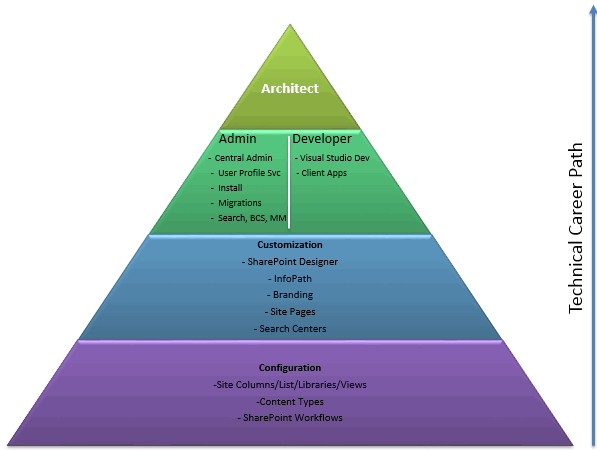As you progress through your SharePoint career you may be starting to wonder what’s next from technical perspective. You may be a developer and want to start writing code, or the thought of writing code makes your hair curl. As I’ve progressed through my 
As you start to look through the pyramid to see where you might be or aspire to be, lets break down each slice of the pyramid.
- Configuration – often times this will be the introductory level of your SharePoint career and are able to effectively work with the businesses power user audience. To do this you should be very familiar with not only what a content type is but the details on how to configure it and use it throughout your site collection. This foundation will lead you to creating browser based workflows and using all the tools in the SharePoint browser experience to create solutions.
- Customization – Now that you have mastered the SharePoint browser experience and your information architecture (content types and list/library structure) has been configured, you are ready to extend SharePoint. Customizing the forms using InfoPath form Services or SharePoint designer for list or libraries is probably your next step. Within this level of expertise you start to really leverage SharePoint designer and some of the advanced web parts that SharePoint has to offer.
- Admin/Developer – This is where you typically reach a fork in the road. It takes a unique person to really want to master the administration side of SharePoint (IE become a PowerShell guru and hang out in Central Administration more than anywhere else) and the development platform (IE Visual studio and the ability to create web parts and custom workflows). This direction can come from personal interest or from a business need.
- Architect – After years of working with everything in SharePoint and possessing the ability to configure just about anything using the SharePoint platform you have the experience and skills necessary to call yourself and architect. Not only do you have a keen understanding of the features and functionality of SharePoint but you also recommend one approach over another because of performance implications, scalability or knowing the recommended thresholds of SharePoint. Architects often possess experience in “supportive” technologies such as being a seasoned .NET developer, a system admin for the domain or a SQL Server DBA. I’ve seen many times where this title is mis-interpreted as someone who understands the core features of SharePoint. Yes this is a pre-requisite but you also need to have a solid understanding of how to get the requirements out of business users so you can apply the proper components or technologies to solve the problem.
Like all technologies that are complex the ability specialize in what interests you the most is what will drive not only personal satisfaction but your success with that chosen technology. Hopefully this will position you for that success. To find out more about this or other ways that McGladrey can assist you with your SharePoint needs, contact McGladrey’s technology consulting professionals at 800.274.3978 or email us.

 RSMUS.com
RSMUS.com